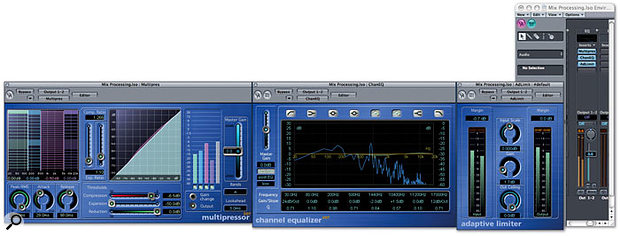 A typical setup for processing a final mix in software, shown here using Logic's Multipressor, Channel EQ and Adaptive Limiter (from left to right).
A typical setup for processing a final mix in software, shown here using Logic's Multipressor, Channel EQ and Adaptive Limiter (from left to right).
I've read the magazine for ages now, and I've also bought some of Paul White's books over the years, but I seem to get different information on the order in which mix processors should be used. What should I have on the master output of Cubase when I export my mix? At the moment I use a dB Audioware compressor and then a limiter in the chain. Also, what settings should I use? Some reports say I should have the compressor across the whole mix at a threshold of 40dB and a ratio of 1.1:1. Is this correct? Also, is there any better software I could use?
Adrian Dix
Editor In Chief Paul White replies: What you do to process your final mix depends on whether you plan to have it professionally mastered or not. If you do, then you should leave the final mix unprocessed, as the mastering house will (or should, at least!) be better equipped than you. However, if you have decent monitors and want to do the job yourself, then what you do depends on what the song needs. With pop music, it's common practice to compress the signal in order to increase its density and loudness.
As you rightly point out, low thresholds and low ratios are the order of the day for mix compression, though different people will suggest different tools for the job. However, whether you're using a multi-band or single-band compressor, it should be followed by a peak limiter to stop clipping. If you plan to make MP3s, its ceiling should be set at around -3dB, rather than 0dB, as even small level peaks can force distortion during the MP3 encoding process. Don't allow the limiter to do too much work; it should only engage on loud peaks, and ideally pull no more than 3-4dB of level from the signal.
If the mix needs EQ, put the EQ before the limiter, but after the compressor (as shown below), as this will give you the most control and will leave the limiter at the end of the chain to prevent clipping. Gentle mid-cut is commonly used to increase clarity and loudness with perhaps some gentle, broad 10kHz to 12kHz boost to increase the sense of presence. Don't overdo the EQ and always compare what you have with some commercial recordings in a similar style, to ensure your tonal balance is about right.
If you want to upgrade, PSP's Vintage Warmer combines compression, EQ, limiting and tube saturation in one affordable package, costing $149 (around £76) from www.pspaudioware.com, whereas if you want to pursue the hardware option, one of the nicest-sounding solutions I've come across is the Drawmer 2476 Masterflow, which provides all the mastering tools you're likely to need in a 1U box. Of course, there are plenty of other alternatives, but the most important thing is to use your ears to decide what processing you need, rather than throw everything at a mix because you can.
